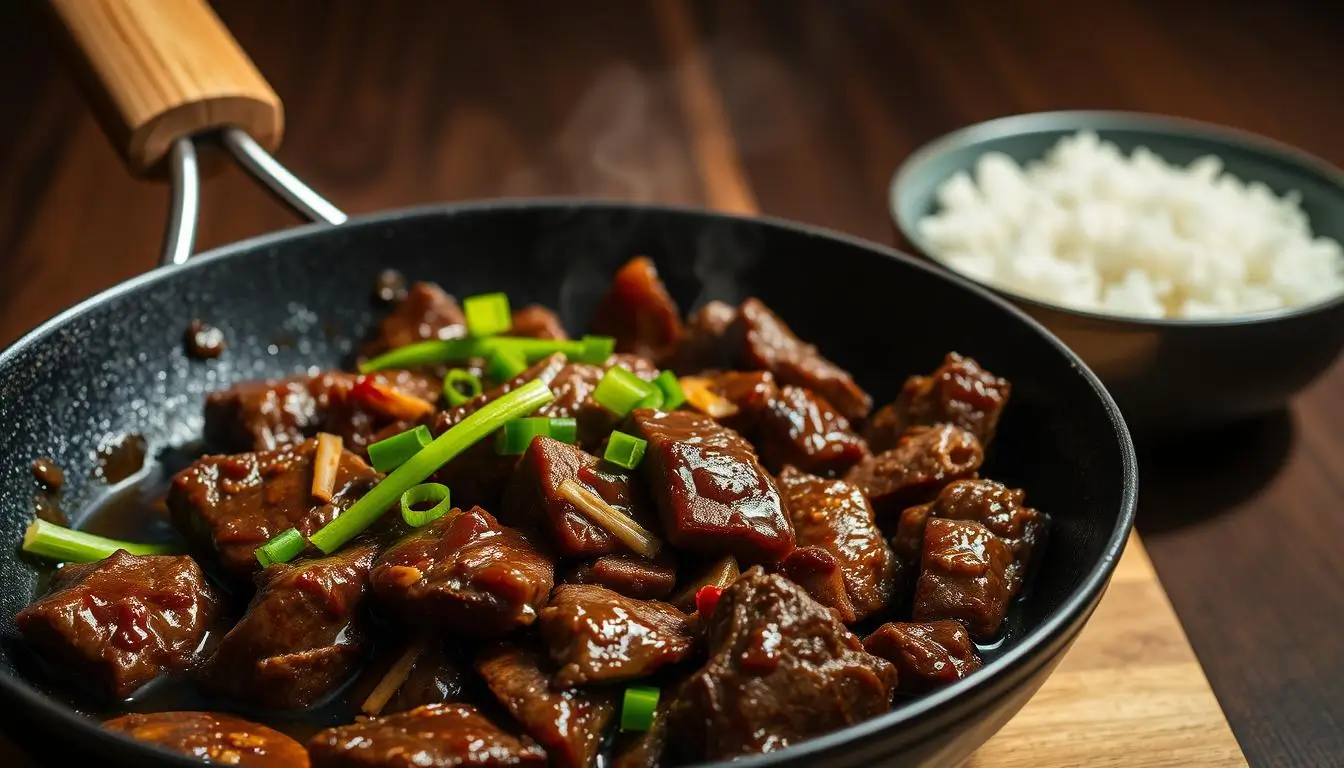I’m excited to share a classic Chinese cuisine dish with you. Mongolian Beef is a tender beef recipe that’s both tasty and simple to make, just like other flavorful dishes such as Greek Salad Recipe and Perfect Tomato Avocado Salad.
Mongolian Beef is a favorite in many restaurants. It’s known for its rich sauce and soft beef. In this article, I’ll show you how to make this dish at home. You’ll get a simple yet true beef recipe.
By following this guide, you can enjoy a top-notch meal at home. Additionally, you can adjust the ingredients to your liking, much like you can with other flavorful dishes, such as Caramelized Onions and Easy Taco Salad.
What is Mongolian Beef?
Mongolian Beef doesn’t come from Mongolia. It’s a fusion of Chinese and American cooking. It’s famous for its tender beef, tasty sauce, and stir-fried veggies.
The Origins and History
The exact start of Mongolian Beef is unclear. Yet, it’s thought to have begun in Chinese restaurants in the U.S. It’s a mix of traditional Chinese cooking and American tastes.
Authentic vs. American-Chinese Versions
The Mongolian Beef in the U.S. is quite different from real Chinese dishes. While Chinese food varies by region, the American version is a blend. It combines Chinese cooking with American flavor likes, as explained by culinary experts at The Woks of Life.
Key Characteristics of the Dish
Mongolian Beef is known for its stir-fried beef and veggies like bell peppers and onions. The sauce is a mix of soy sauce, hoisin sauce, and more. This gives the dish its unique taste.
| Characteristics | Description |
|---|---|
| Main Ingredients | Beef, vegetables (like bell peppers and onions), savory sauce |
| Cooking Method | Stir-fry |
| Flavor Profile | Savory, slightly sweet, and spicy |
Understanding the Key Ingredients
Making Mongolian Beef is more than just a recipe. It’s about picking the best ingredients. The dish’s taste and texture come from these key parts.
Selecting the Right Cut of Beef
Choosing the right beef is key for Mongolian Beef. Flank steak or skirt steak are top picks. They are tender and flavorful when sliced right.
“Using the right cut of beef, such as flank steak, ensures that your Mongolian Beef is tender and flavorful,”
Notes a famous chef.
Essential Sauce Components
The sauce is what makes Mongolian Beef special. It’s made from soy sauce, hoisin sauce, and oyster sauce (if used). These add depth and umami. Sugar and vinegar balance it out, making it sweet and savory.
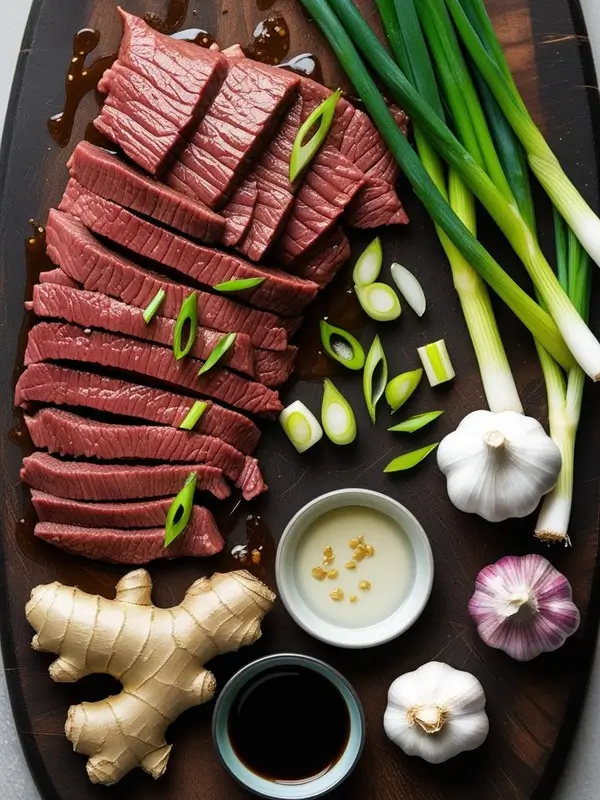
Aromatics and Vegetables
Garlic and ginger are essential. They add a strong flavor that goes well with the beef. Bell peppers and scallions add color, texture, and freshness.
Ingredient Substitutions
If you need to make changes, you can. Use gluten-free soy sauce instead of regular. For a meatless option, try vegetarian oyster sauce. The goal is to keep the flavors balanced.
Knowing and choosing the right ingredients helps make a tasty Mongolian Beef. It can fit your taste and dietary needs.
Equipment You’ll Need
To cook Mongolian Beef, you need the right cooking equipment. This ensures the perfect mix of flavors and textures. Choosing between a wok and a frying pan is key.
Wok vs. Frying Pan Options
A wok is best for Mongolian Beef because of its large, deep shape. It’s great for quick stir-frying. But, if you don’t have a wok, a big frying pan works well too.
- A wok offers even heat and is perfect for stir-frying.
- A frying pan is easy to find and can get similar results with the right technique.
Other Essential Kitchen Tools
You’ll also need other kitchen tools to make Mongolian Beef well.
- A sharp knife for slicing the beef thinly.
- A cutting board for chopping ingredients.
- A spatula for stir-frying.
- Measuring cups and spoons for the right amounts.
Setting Up Your Cooking Station
Before cooking, set up your station well. Place all ingredients where you can easily reach them. This makes cooking smoother, as recommended by cooking experts at Spend with Pennies.

Preparing the Beef for Maximum Tenderness
Getting the beef tender is crucial for great Mongolian Beef. Tender beef makes the dish more enjoyable. It also lets the flavors soak in better.
Proper Slicing Techniques
Slicing the beef right is key to tenderness. Cutting against the grain makes it tender and easy to chew. Use a sharp knife to slice into thin strips, cutting across muscle fibers.
Tip: Freezing the beef for 30 minutes before slicing helps. It makes the meat firmer, easier to slice thinly and evenly, similar to proper meat preparation techniques used in dishes like Ground Beef Stir Fry and Street Corn Chicken Rice Bowl.
The Velveting Method Explained
Velouté is a Chinese technique for tender beef. It involves marinating in a mix of cornstarch, egg whites, and seasonings. This method tenderizes the beef and adds a silky texture.
To velvet beef:
- Slice the beef into thin strips.
- Mix the beef with your chosen velveting ingredients.
- Let it marinate for at least 30 minutes.
- Rinse the beef gently before cooking to remove excess marinade.
Effective Marinating Tips
Marinating tenderizes beef well. A good marinade has acidic ingredients like soy sauce or vinegar. These break down meat proteins.
| Marinade Component | Function |
|---|---|
| Soy Sauce or Vinegar | Acidic ingredients that help tenderize the beef. |
| Garlic and Ginger | Add flavor and help tenderize the meat. |
| Cornstarch or Flour | Help thicken the marinade and coat the beef. |
Tenderizing Alternatives
Looking for other ways to tenderize beef? Pounding it thin with a meat mallet works. You can also use tenderizing tools or enzymes like papain.
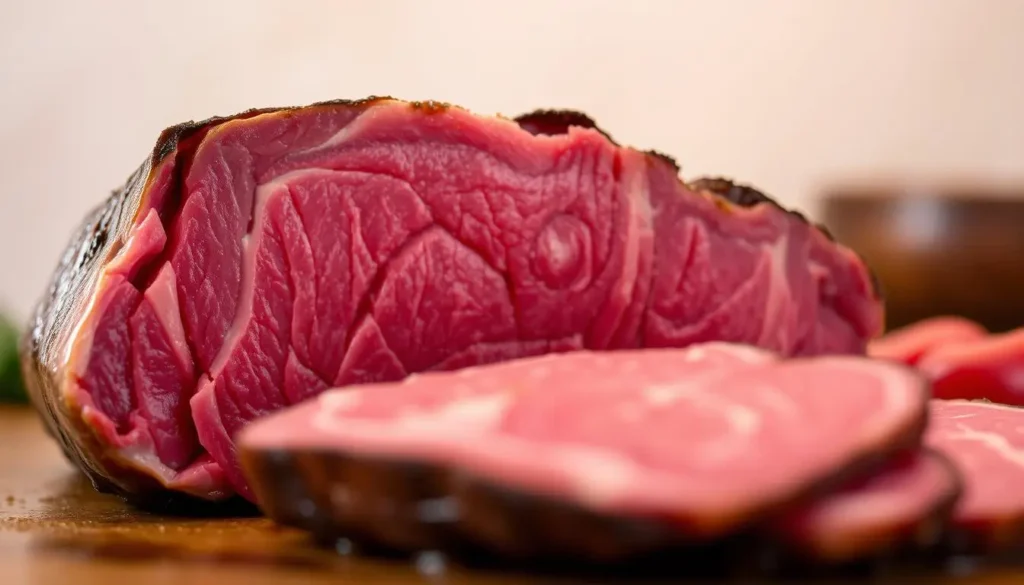
Creating the Perfect Mongolian Beef Sauce
The secret to great Mongolian Beef is its sauce. It’s easy to make and makes the dish special. A good sauce can make any meal stand out.
Base Sauce Ingredients
The base of Mongolian Beef sauce is soy sauce, hoisin sauce, and rice vinegar. These give it a deep, savory taste. You can add more to make it even better.
- Soy sauce for umami flavor
- Hoisin sauce for sweetness and thickness
- Rice vinegar for a touch of acidity
Balancing Sweet and Savory Flavors
Getting the sweet and savory balance right is key. Adjust the hoisin sauce for sweetness. Soy sauce and rice vinegar keep it savory. A little brown sugar can also help balance the flavors.
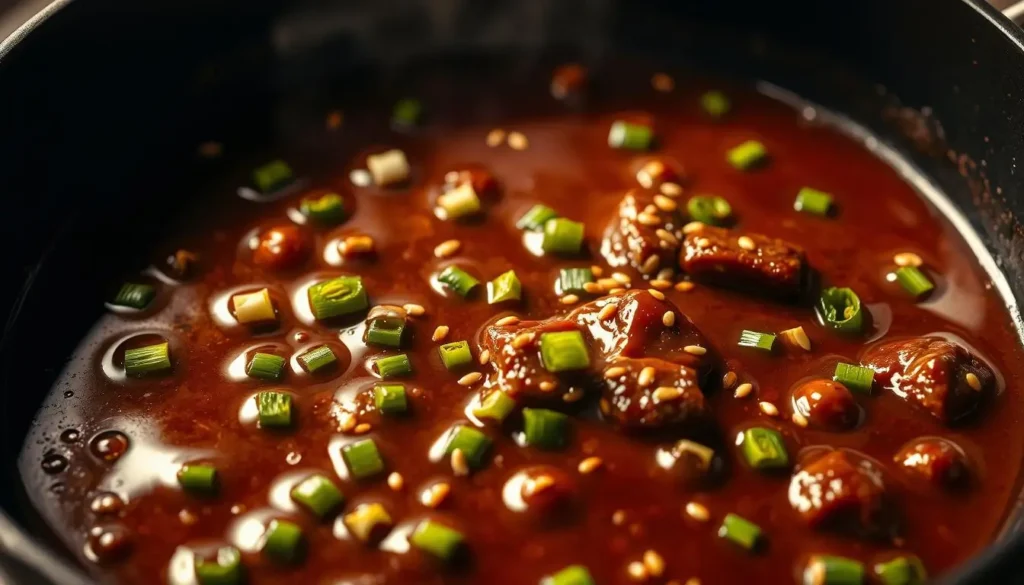
Adjusting Spice Levels
For some heat, add red pepper flakes or sriracha. Start with a little and adjust to taste. Too much heat can be overwhelming.
- Add a small amount of red pepper flakes or sriracha
- Taste and adjust according to your preference
Make-Ahead and Storage Tips
Mongolian Beef sauce is great because you can make it ahead. Store it in an airtight container in the fridge for up to a week. Reheat it gently before using.
By following these tips, you can make a Mongolian Beef sauce that suits your taste. Whether you prefer it sweet, savory, or spicy, you can make the perfect sauce, as suggested by culinary experts at Recipe Tin Eats.
Step-by-Step Cooking Process
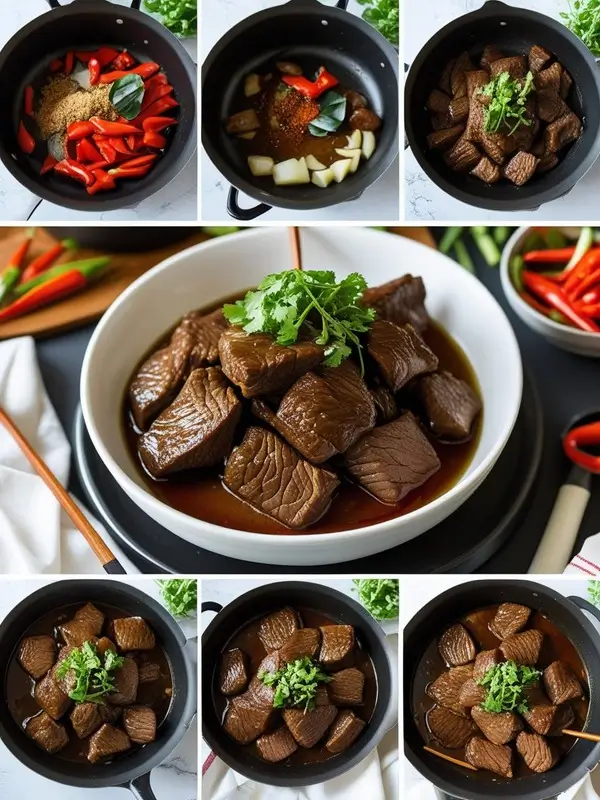
To make Mongolian Beef, follow this easy guide. It ensures a tasty and authentic dish. The steps are key to a tender and flavorful meal.
Step 1: Preparing Your Ingredients
Start by preparing all your ingredients. Slice the beef thinly, chop the veggies, and measure the sauce. Good prep makes cooking smooth and fast.
I organize my ingredients by order of use. This helps me follow the recipe without pause.
Step 2: Frying the Beef to Perfection
Next, fry the beef to perfection. Heat a wok or large pan over high heat. Add oil and stir-fry the beef until it’s cooked through. Aim for a tender, slightly caramelized exterior.
Tips for Frying Beef:
- Use high heat for a quick sear.
- Cook in batches to avoid overcrowding.
- Stir constantly to prevent burning.
Step 3: Creating the Sauce
While the beef cooks, prepare the sauce. Mix soy sauce, hoisin sauce, and rice vinegar in a bowl. Cook the sauce in the pan until it thickens, adding a rich flavor.
Step 4: Combining and Finishing the Dish
Finally, mix the cooked beef with the sauce and add veggies. Stir well to coat the beef with sauce. Serve hot, garnished with green onions and sesame seeds if you like.
| Step | Description | Tips |
|---|---|---|
| 1 | Prepare ingredients | Slice beef thinly, chop vegetables |
| 2 | Fry beef | Use high heat, don’t overcrowd |
| 3 | Create sauce | Combine sauce ingredients, cook until thickened |
| 4 | Combine and serve | Add vegetables, garnish with green onions |
Popular Variations of Mongolian Beef
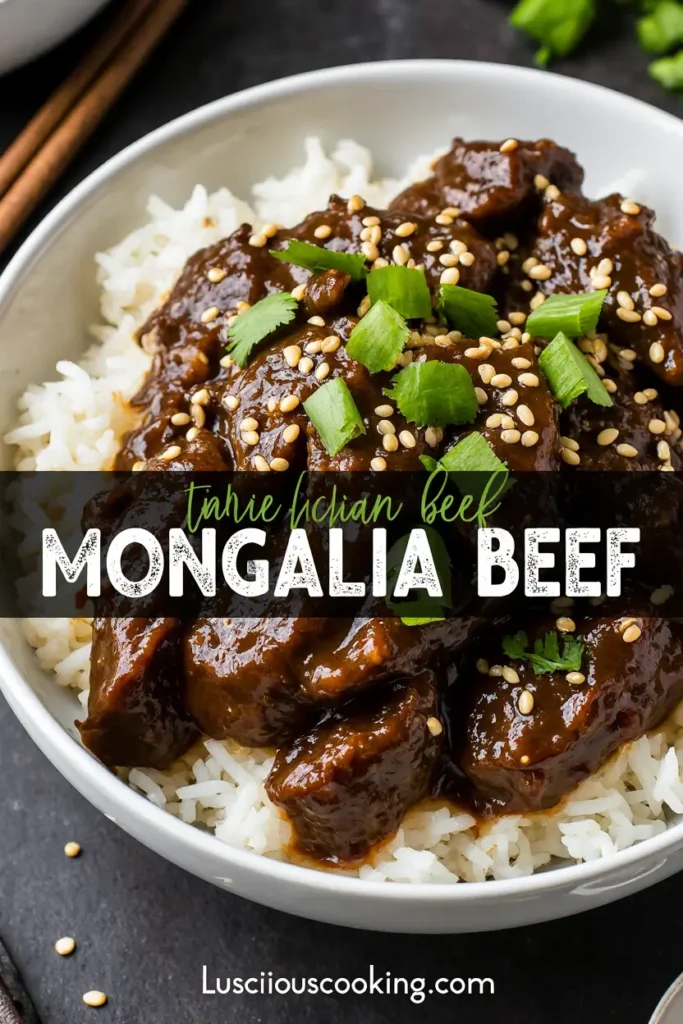
Mongolian Beef comes in many exciting flavors. It’s loved for its versatility. Whether you want something spicy or packed with veggies, there’s a version for you, just like other versatile dishes such as Cheesy Chicken Enchiladas.
Spicy Mongolian Beef
For those who like a little heat, spicy Mongolian Beef is perfect. You can add Sriracha, red pepper flakes, or sliced jalapeños to the sauce. This adds a bold flavor that pairs well with the beef.
Vegetable-Packed Versions
Adding veggies makes Mongolian Beef healthier and more colorful. Try using bell peppers, snow peas, and mushrooms. Stir-frying them with the beef makes for a filling meal.
Healthier Adaptations
To make Mongolian Beef healthier, use leaner beef like sirloin or tenderloin. Use less oil and add more veggies. You can also swap some sauce ingredients for healthier options, like low-sodium soy sauce.
Regional Differences
Mongolian Beef varies by region, showing local tastes. Some versions use unique spices or ingredients. Trying these can introduce new flavors and ideas.
Common Mistakes to Avoid When Cooking Mongolian Beef
To make Mongolian Beef like a pro, you must steer clear of common mistakes. Cooking this dish can be tricky. But knowing the pitfalls can greatly improve your results.
Overcooking the Beef
Overcooking the beef is a big mistake. It makes the meat tough and chewy, spoiling the dish. To prevent this, cook the beef quickly over high heat. Also, don’t overcrowd the wok or pan.
Sauce Consistency Issues
Getting the sauce consistency right is another challenge. The sauce should coat the beef well but not be too thick. You can adjust the cornstarch or cooking time to get it just right.
| Issue | Solution |
|---|---|
| Too thick | Add a little water or broth |
| Too thin | Increase cornstarch or cook longer |
Flavor Balance Problems
Flavor balance is key. Too much soy sauce can make it too salty. Too little, and it lacks depth. Tasting as you go and adjusting the seasoning is essential for a balanced flavor.
Timing and Preparation Errors
Lastly, timing and preparation are vital. Have all ingredients ready and cooked in the right order. Preparing ahead of time can prevent last-minute stress.
Mastering Mongolian Beef needs focus and a few important tips. Knowing the value of quality ingredients and technique helps make a dish tender and tasty. The secret to great Mongolian Beef is its savory sauce, tender beef, and balanced aromatics.
Choosing the right beef, velveting it, and making a balanced sauce are key. These steps help make excellent Mongolian Beef. By following these tips and trying different variations, you can make the dish your own.
Mongolian Beef is a dish that can be made to fit many tastes. With practice and patience, you can make a Mongolian Beef that rivals restaurant quality. Keep improving your cooking skills and try new ingredients and techniques. This will help you make the recipe your own, leading to a perfect dish.
FAQ
What is the best cut of beef for Mongolian Beef?
Flank steak or skirt steak is great for Mongolian Beef. They are tender and taste good. Flank steak is lean and firm, while skirt steak has a stronger flavor.
Can I make Mongolian Beef without a wok?
Yes, you can make it in a large frying pan or skillet. A wok is best for stir-frying, but a non-stick pan works well too.
How do I achieve tender beef in Mongolian Beef?
To get tender beef, slice it against the grain and use the velveting method. Marinate it with cornstarch, soy sauce, and rice vinegar. This makes the beef tender.
What are some common mistakes to avoid when cooking Mongolian Beef?
Avoid overcooking the beef and sauce consistency issues. Also, balance the flavor and watch your timing. Following a recipe and using quality ingredients helps.
Can I make Mongolian Beef sauce ahead of time?
Yes, you can make the sauce a day in advance. Store it in the fridge. Reheat it before using.

